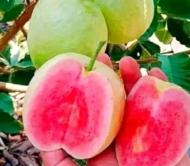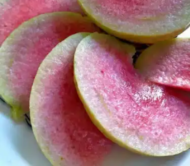-66%








₹950.00 ₹320.00
Details:
Exterior (Skin): Bright to deep reddish-pink skin when fully ripe, sometimes with a slight green hue in early stages.
Interior (Flesh): Rich, vibrant red to crimson color – highly attractive and distinctive.
Medium to large-sized fruits.
Average length: 7–10 cm
Average diameter: 6–9 cm
Average fruit weight: 250–450 grams
Some fruits can reach up to 500 grams under ideal cultivation conditions.
Flavor profile: Very sweet with low acidity, mild aroma.
Highly palatable, ideal for fresh consumption and juices.
Less seed content compared to other guavas, which enhances eating quality.
TSS Range: 12 to 14 °Brix
TSS indicates the level of natural sugars and soluble nutrients, which reflects high sweetness.
Typically ranges from 12 to 14° Brix, sometimes reaching 15° Brix in fully mature fruits.
Indicates high sugar content and desirable sweetness level.
If you need information on cultivation, climatic needs, or disease resistance for Red Diamond Guava, feel free to ask!
| Weight | 1 kg |
|---|---|
| Dimensions | 60.96 cm |
2500 in stock
Best climate: Subtropical and tropical.
Temperature range: 20°C – 35°C (ideal: 25–30°C).
Frost-sensitive: Protect young plants from frost.
Tolerates both dry and humid conditions, but performs best in moderate humidity.
Soil type: Well-drained loamy soil is ideal.
pH range: 5.5 to 7.5
Avoid waterlogged or alkaline soils.
Enrich soil with organic matter before planting.
Spacing: 10 ft × 10 ft or 12 ft × 12 ft for open field planting (approx. 300–450 plants/acre).
Planting time:
Rainfed areas: Start of monsoon (June–July).
Irrigated areas: February–March or August–September.
Pit size: 1 ft × 1 ft × 1 ft, filled with topsoil, compost (10–15 kg/pit), and neem cake (200g).
Frequency:
Every 7–10 days in summer.
Every 15–20 days in winter.
Avoid overwatering; ensure proper drainage.
Drip irrigation is recommended for water efficiency.
| Age | FYM (kg) | Urea (g) | SSP (g) | MOP (g) |
|---|---|---|---|---|
| 1 year | 10–15 | 100 | 250 | 100 |
| 2 year | 15–25 | 200 | 400 | 150 |
| Mature | 30–40 | 400 | 500 | 250 |
Apply in 2–3 split doses: before flowering and after fruit set.
Add micronutrients like zinc, boron, and magnesium if deficiency symptoms appear.
Time: After harvest or before the monsoon.
Remove dead, diseased, and crossing branches.
Light pruning improves air circulation and fruit quality.
First flowering: 8–12 months after planting (in grafted plants).
Main flowering:
Spring (Feb–Mar) – Harvest in rainy season (Jul–Aug)
Monsoon (Jun–Jul) – Harvest in winter (Nov–Jan)
Fruits mature 90–120 days after flowering.
| Problem | Symptoms | Control |
|---|---|---|
| Fruit Fly | Larvae in fruit | Use pheromone traps, neem oil spray |
| Aphids & Mealybugs | Sticky leaves | Neem oil or insecticidal soap |
| Anthracnose | Fruit rot | Use copper fungicide spray |
| Wilt | Yellowing, death | Soil sterilization, remove infected plants |
Year 1–2: 8–15 kg/plant
Year 3 onwards: 25–40 kg/plant
Per acre yield: 8–12 tons (with good care and spacing)
Harvest at 80–90% maturity (firm but fully colored).
Handle carefully to avoid bruising.
Can be stored at 8–10°C for 7–10 days.
If you’d like, I can also help you prepare a BOQ (Bill of Quantities) or a business plan for commercial cultivation. Let me know!
No account yet?
Create an Account
Reviews
Clear filtersThere are no reviews yet.